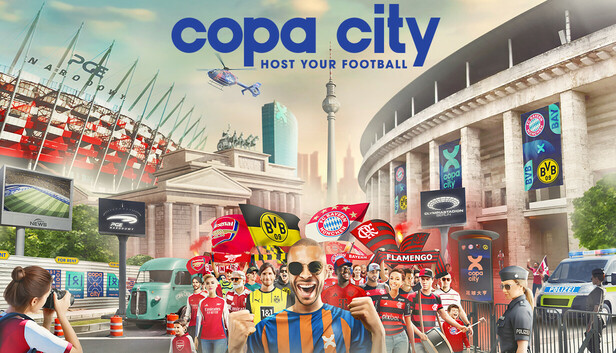Copa City: Build Your Football Empire, Host the World's Game
Football isn't just a sport; it's a global phenomenon, a cultural touchstone that unites billions. For many, the dream of being intimately involved, not just as a fan but as an architect of the game's greatest spectacles, remains just that – a dream. Until now. Enter Copa City, a revolutionary new game that transcends traditional sports management simulations, thrusting players into the unprecedented role of a football city host. This isn't merely about assembling a dream team or managing a club's finances; it's about crafting an entire urban landscape dedicated to the beautiful game, attracting global tournaments, and etching your city's name into the annals of football history. Copa City offers an unparalleled depth of simulation, blending urban planning, economic strategy, and the pulsating drama of live football into a single, cohesive experience. Are you ready to lay the foundations, build the stadiums, and orchestrate the ultimate footballing spectacle? The world is watching.
The Genesis of a Dream: From Concept to Kick-off
Every grand vision begins with a spark, and Copa City is no testament to the enduring allure of football and the desire to create a truly immersive experience. The developers, a passionate team of football fanatics and gaming veterans, envisioned a game that went beyond the familiar confines of club management. They wanted to capture the broader ecosystem of football – the infrastructure, the economics, the cultural impact – all centered around the concept of hosting major tournaments.
This ambitious undertaking involved countless hours of research, delving into the intricacies of urban planning, stadium architecture, transportation logistics, and event management. The goal was not just to create a game, but to build a living, breathing footballing world where every decision had a tangible impact, where the success of your city hinged on meticulous planning and shrewd investment.
Laying the Foundations: Urban Planning and Infrastructure
Before the roar of the crowd can fill your stadium, you must first lay the very groundwork of your footballing metropolis. Copa City places you squarely in the mayor's chair, tasking you with the critical decisions of urban planning. This isn't just about slapping down a few buildings; it's about creating a harmonious and efficient city that can support the demands of global football.
Your initial choices in city layout will have long-lasting consequences. Do you prioritize sprawling residential areas to house a growing population of fans and workers, or do you allocate prime real estate for commercial ventures that will fuel your economy? The strategic placement of roads, public transport networks, and utility infrastructure is paramount. A well-designed city ensures smooth traffic flow, efficient resource distribution, and ultimately, a positive experience for both your residents and the throngs of visiting fans.
Zoning for Success: Residential, Commercial, Industrial
- Residential Zones: These are the lifeblood of your city, providing housing for your workforce, from construction workers to stadium staff. A happy populace means a productive workforce.
- Commercial Zones: These areas generate income through shops, restaurants, and entertainment venues, catering to both residents and tourists.
- Industrial Zones: Essential for producing construction materials and other resources needed for your city's expansion.
Public Services: The Unsung Heroes
- Healthcare: A healthy city is a productive city. Hospitals and clinics are crucial for maintaining public well-being.
- Education: Schools and universities nurture a skilled workforce, vital for managing complex operations and technological advancements.
- Security: Police and fire services ensure safety and order, especially during large-scale events.
Building the Colosseum: Stadium Construction and Expansion
The crown jewel of any football city is its stadium. In Copa City, this isn't a pre-built asset; it's a monumental construction project that evolves with your ambitions. You start with a modest ground, perhaps a local league venue, but your ultimate goal is to erect a colossal arena capable of hosting the grandest tournaments on Earth.
The stadium construction module offers unparalleled customization. You choose the architectural style, the seating capacity, the type of pitch, and even the finer details like luxury boxes, media centers, and hospitality suites. Each upgrade comes with a significant cost and construction time, demanding careful financial planning. The decision of when and how to expand is critical, balancing the immediate needs of your local league with the long-term vision of attracting international events.
Phased Development: From Local Ground to Global Icon
- Tier 1: Community Pitch: A basic stadium suitable for amateur leagues and local matches. Limited capacity and amenities.
- Tier 2: Regional Arena: Larger capacity, basic facilities for restrooms and concessions. Can host lower-tier professional matches.
- Tier 3: National Stadium: Significant capacity, modern amenities, VIP areas, and improved media facilities. Capable of hosting domestic cup finals and international friendlies.
- Tier 4: Global Superdome: Massive capacity, state-of-the-art technology, extensive hospitality, and media infrastructure. Designed to host major international tournaments like the Copa City World Cup.
Beyond the Stands: Ancillary Facilities
- Training Grounds: Essential for attracting and developing top-tier football clubs.
- Fan Zones: Designated areas outside the stadium for pre-match festivities, entertainment, and merchandise sales, enhancing the matchday experience.
- Parking and Transport Hubs: Crucial for managing the influx of fans on match days, ensuring smooth ingress and egress.
The Economic Engine: Managing Your City's Finances
A football city, no matter how grand, cannot survive on passion alone. It requires a robust economic engine to fund its expansion, maintain its infrastructure, and attract top talent. Copa City presents a complex economic simulation where every decision has financial ramifications. Your income streams will be diverse, ranging from ticket sales and merchandise revenue to commercial sponsorships and tourism.
Conversely, your expenses will be equally varied, encompassing construction costs, maintenance fees, staff wages, and security outlays. Maintaining a healthy balance sheet is paramount. You'll need to make shrewd investments, identify opportunities for growth, and be prepared to tighten your belt during lean times. Failing to manage your finances effectively can lead to bankruptcy and the collapse of your footballing dream.
Revenue Streams: Fueling Your Ambition
- Ticket Sales: The most direct income from matches. Pricing strategy is key – balance affordability with maximizing revenue.
- Merchandise Sales: Team jerseys, scarves, and souvenirs generate significant income, especially for popular clubs.
- Commercial Sponsorships: Attract corporate partners for stadium naming rights, advertising hoardings, and team kits.
- Tourism: Visitors drawn to your football city spend money on hotels, restaurants, and other services.
- Broadcast Rights: Hosting major tournaments can generate substantial revenue from television rights.
Expenditure: The Cost of Greatness
- Construction and Upgrades: The largest initial outlay for building stadiums and infrastructure.
- Maintenance: Ongoing costs for keeping your facilities in top condition.
- Staff Wages: Paying your city and stadium employees.
- Security: Ensuring the safety of fans and players, especially during large events.
- Marketing and Promotion: Attracting visitors and securing bids for tournaments.
Attracting the Stars: Club Management and Development
While your focus is on the city, you cannot have a thriving football metropolis without successful clubs to call it home. Copa City allows you to influence the development of local clubs, from grassroots academies to professional powerhouses. You can invest in training facilities, youth development programs, and even offer financial incentives to attract top players and coaches.
The success of your resident clubs directly impacts your city's reputation and attractiveness as a host. A strong local league and competitive teams will draw larger crowds, generate more revenue, and elevate your city's profile on the global footballing stage. You'll need to strike a balance between providing resources and allowing clubs to develop organically, fostering a vibrant and competitive footballing ecosystem.
The Grand Stage: Bidding for Tournaments
The ultimate goal in Copa City is to host the biggest and most prestigious football tournaments in the world. This is where all your efforts in urban planning, stadium construction, and economic management converge. Bidding for tournaments is a rigorous process, requiring a compelling presentation of your city's capabilities, infrastructure, and financial guarantees.
You'll compete against other AI-controlled cities, each vying for the same prize. Success hinges on a combination of factors: the quality of your stadiums, the efficiency of your transport networks, the vibrancy of your fan zones, and your commitment to security and sustainability. Winning a bid is not just a matter of prestige; it unlocks massive economic benefits, boosts tourism, and solidifies your city's status as a global footballing hub.
The Bidding Process: A High-Stakes Game
- Initial Application: Submit a comprehensive dossier outlining your city's capabilities and vision.
- Inspection Visits: Hosting delegations from the football governing bodies to showcase your facilities.
- Presentation and Lobbying: Delivering persuasive presentations and engaging in diplomatic efforts to sway votes.
- Financial Guarantees: Demonstrating the financial stability and commitment to host the event.
Tournament Tiers: From Regional Cups to Global Championships
- Local Cups: Small-scale tournaments involving your city's resident clubs.
- National Leagues and Cups: Hosting regular league matches and domestic cup finals.
- Continental Championships: Events like the Copa Libertadores or Champions League, requiring higher standards.
- The Copa City World Cup: The pinnacle of your ambition, demanding world-class infrastructure and meticulous planning.
The Match Day Experience: Logistics and Crowd Management
Hosting a major tournament is a logistical marvel. On match days, your city transforms into a buzzing hive of activity. You'll be responsible for managing everything from crowd flow and public transport to security and emergency services. A seamless match day experience is crucial for both fan satisfaction and the long-term reputation of your city.
Copa City's simulation engine meticulously tracks crowd movements, traffic congestion, and security incidents. You'll need to deploy adequate police forces, medical personnel, and event staff to ensure the safety and comfort of thousands of spectators. A single misstep can lead to negative publicity and jeopardize future bids.
Key Logistical Considerations
- Transportation Networks: Ensuring efficient public transport, shuttle services, and parking solutions.
- Security Personnel: Deploying sufficient police and private security to manage crowds and prevent incidents.
- Medical Services: Setting up first aid stations and ensuring quick response times for emergencies.
- Food and Beverage: Providing ample catering options within and around the stadium.
- Waste Management: Efficiently handling the large volume of waste generated on match days.
Beyond the Final Whistle: Legacy and Sustainability
The final whistle of a major tournament isn't the end; it's the beginning of your city's legacy. Copa City encourages long-term planning and sustainable development. How will your grand stadiums be utilized after the crowds disperse? What economic benefits will linger?
You'll need to devise strategies for post-tournament use, whether it's attracting a permanent football club, hosting concerts and other events, or converting parts of the stadium for other purposes. Sustainable practices, such as renewable energy sources and waste recycling, will also play a role in your city's long-term viability and global standing.
Post-Tournament Utilization
- Permanent Club Residence: Attracting a top-tier football club to make your stadium its home.
- Multi-Purpose Venue: Adapting the stadium to host concerts, conferences, and other sporting events.
- Community Hub: Utilizing parts of the stadium for local sports, education, or cultural activities.
Environmental Responsibility
- Green Building Practices: Incorporating sustainable materials and energy-efficient designs in construction.
- Waste Reduction and Recycling: Implementing comprehensive waste management programs.
- Public Transport Promotion: Encouraging the use of public transport to reduce carbon emissions.
The Unpredictable Nature of the Beautiful Game: Events and Challenges
Just like in real life, Copa City is filled with unforeseen events and challenges that will test your leadership. From economic downturns and natural disasters to fan unrest and player controversies, you'll need to be adaptable and resilient. These challenges aren't just obstacles; they are opportunities to demonstrate your crisis management skills and strengthen your city's foundations.
A well-prepared city, with robust emergency protocols and diverse economic streams, will be better equipped to weather these storms. The ability to react swiftly and decisively to unexpected situations will define your success as a football city host.
Common Challenges
- Economic Recessions: Impacting tourism, business revenue, and your city's overall budget.
- Natural Disasters: Requiring immediate response and potentially causing damage to infrastructure.
- Public Unrest: Protests or riots that can disrupt events and damage your city's reputation.
- Security Threats: Requiring heightened security measures and swift responses.
- Scandals and Controversies: Affecting the image of your clubs or the integrity of your hosted events.
The Ultimate Footballing Dynasty: Your Legacy
Copa City isn't just about winning a single bid or hosting one successful tournament. It's about building a lasting legacy, a footballing dynasty that transcends generations. Your decisions will shape the future of your city, influencing its culture, economy, and global standing. The game provides a dynamic historical record of your achievements, allowing you to witness the evolution of your city from a humble settlement into a world-renowned footballing capital.
Will your city become the next Rio, London, or Madrid – synonymous with the beautiful game? Will your name be etched into the pantheon of legendary footballing architects? Copa City empowers you to answer these questions, to turn your wildest footballing dreams into a tangible, thriving reality. The journey is long, the challenges are many, but the reward – the ultimate footballing dynasty – is immeasurable.
Conclusion
Copa City is more than just a game; it's a profound exploration of what it means to build, manage, and sustain a city dedicated to the world's most beloved sport. It masterfully blends the intricate details of urban planning with the pulsating excitement of football, offering a truly unique and deeply engaging experience. From the initial groundbreaking to the final whistle of a world championship, every decision carries weight, every success feels earned, and every challenge overcome strengthens your resolve. This game is a testament to the power of vision, strategic thinking, and an unwavering passion for the beautiful game. For those who have ever dreamed of shaping the destiny of football beyond the confines of the pitch, Copa City offers an unparalleled opportunity to truly host your football city and leave an indelible mark on the sporting world. The ball is now in your court – are you ready to kick off your legacy?





























